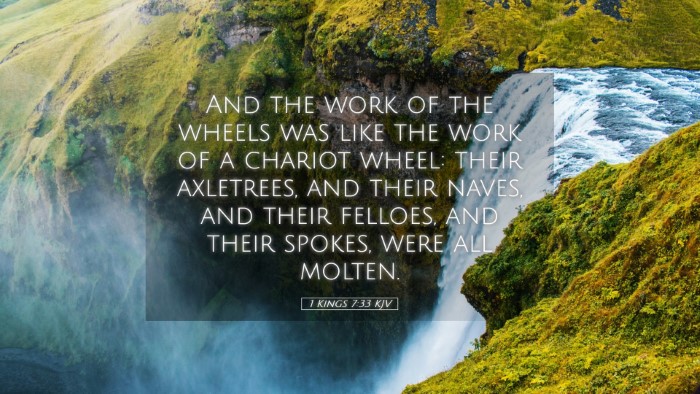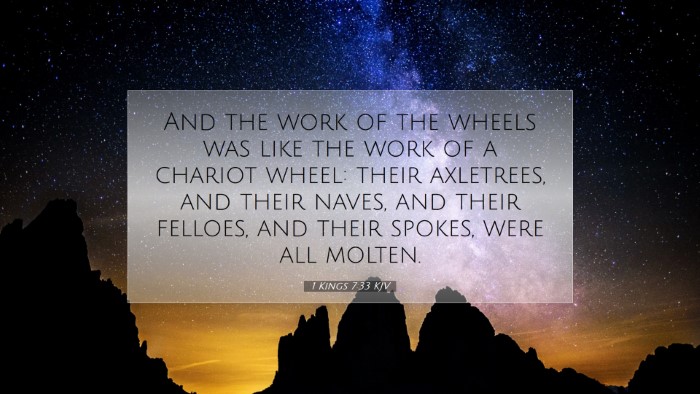Commentary on 1 Kings 7:33
Verse: "And the wheels were made like the wheel of a chariot: their axles, and their knops, and their felloes, were all molten." - 1 Kings 7:33
Introduction
This verse describes some of the intricate details of the construction of the chariots made for the temple by King Solomon. The imagery of the wheels is significant, as it demonstrates both the artistic craftsmanship and the functional necessity of these items in ancient Israelite culture.
Overview of Commentaries
The public domain commentaries examined herein—by Matthew Henry, Albert Barnes, and Adam Clarke—offer rich insights into the theological and practical implications of this verse. Their collective perspectives enhance our understanding of its significance in both historical and spiritual contexts.
Matthew Henry's Commentary
Matthew Henry emphasizes the practical construction of the chariots and draws attention to the importance of functionality along with beauty. He notes that the wheels' designs, resembling those of a chariot, reflect a blend of aesthetic value and robust purpose.
Key Insights from Henry:
- Symbol of Majesty: The chariot wheels represent the majesty of the king and the glory of God's sanctuary.
- Connection to Divine Order: The meticulous crafting signifies God's order and excellence in all things, mirroring the divine order in creation.
- Craftsmanship as Worship: Henry indicates that the skillfulness of the artisans can be seen as a form of worship, where the beauty of the temple elements reflects the beauty of the Creator.
Albert Barnes' Commentary
Albert Barnes provides a detailed exposition of the construction elements mentioned in the verse. He breaks down the terms used to describe the wheels, axles, knops, and felloes, allowing readers to appreciate both the functionality and symbolic meanings behind these components.
Key Insights from Barnes:
- Technological Understanding: Barnes points out the advanced technology involved in making these wheels, highlighting the sophistication of the workmanship during Solomon's reign.
- Symbolism of the Wheel: The wheel can symbolize movement and progress, suggesting that God's kingdom is active and moving toward fulfillment.
- Holiness of the Temple Items: Each element of the design is significant, as everything that was made for the temple was intended to bring glory to God, solidifying the place as holy ground.
Adam Clarke's Commentary
Adam Clarke's commentary dives deeper into the implications of the verse's language. He explores the Hebrew terminology and discusses the artistic significance of the designs. Clarke's insight into the historical context surrounding the chariots adds depth to the understanding of their purpose.
Key Insights from Clarke:
- Historical Context: Clarke highlights that these chariots were likely used for both ceremonial roles and practical purposes, emphasizing their importance in ancient Israelite society.
- Focus on Divine Design: He draws attention to the fact that the meticulous details of the design reflect God's own design for His people—ordered, beautiful, and purposeful.
- Illustration of Spiritual Truths: The wheel's ability to roll freely reflects the spiritual journey of believers—an ongoing movement in faith, embodying growth and direction in God’s purpose.
Theological Implications
The construction of the chariot wheels in Solomon’s temple carries significant theological meanings, reflecting broader biblical themes:
- Divine Sovereignty: The careful and detailed design reflects God's sovereignty over creation and His desire for order in worship.
- Beauty in Holiness: The aesthetics of the temple items point to the beauty of holiness; God is not just to be worshiped, but worshiped beautifully.
- Role of Artisanship: The skill and dedication of the artisans symbolize the importance of human effort in the divine plan, suggesting that labor for God’s glory is inherently valuable.
Practical Applications
For pastors, students, theologians, and Bible scholars, the insights derived from 1 Kings 7:33 can be applied in various contexts:
- Worship and Dedication: Understanding the significance of beauty and excellence in worship can inspire contemporary church practices to prioritize the quality of expressions of faith.
- Leadership Lessons: The collaborative effort in constructing the temple reminds leaders of the importance of teamwork in fulfilling God's mission.
- Encouragement for Creativity: The call to create divine beauty in ministry can motivate individuals to use their artistic gifts as a means of honoring God.
Conclusion
The verse 1 Kings 7:33 serves as a profound reminder of the intersection between artistic expression and worship. Through the commentaries of esteemed scholars like Matthew Henry, Albert Barnes, and Adam Clarke, we glean valuable insights that enrich our understanding of the text and its implications for faith and practice.


